
March 31, 2015
I ate Fair Oaks Park. Not all of it, but a fair portion of it in a three-hour foraging walk around the Dallas park. Better known for its sprawling sports fields and nearby trash transfer station, the venue offered students of Mark Suter's Primitive Texas wild edible plants class plenty to eat during a mid-March hike. We were barely out of the parking lot when Suter stopped to give us a discourse on dandelion.
“Highly nutritious, all of it, and unlike a lot of plants we’ll see today available year round.”
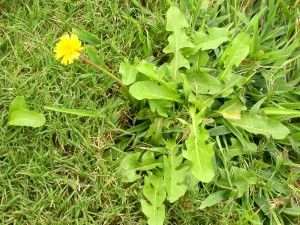 Suter pried the tap-rooted plant out of the ground using his Native American digging tool. The four-foot-long, two-inch thick oak stick had a chisel tip crafted on one end. Using a Native American technique called fire hardening, the tip was baked without charring in hot coals to cook out all moisture. At the other end was wrapped a long thick string. By holding the unraveled string on one end, the stick is thrown over a branch to bend it and bring the flowers or fruit into reach.
Suter pried the tap-rooted plant out of the ground using his Native American digging tool. The four-foot-long, two-inch thick oak stick had a chisel tip crafted on one end. Using a Native American technique called fire hardening, the tip was baked without charring in hot coals to cook out all moisture. At the other end was wrapped a long thick string. By holding the unraveled string on one end, the stick is thrown over a branch to bend it and bring the flowers or fruit into reach.
Above, Consider eating some of those "highly nutritious" dandelions in your yard. Courtesy of Texas AgriLife Extension Center.
“It’s very effective for digging up edible plant roots,” said Suter.
He swiftly popped the dandelion, considered by many to be a common weed, out of the ground and shook the dirt off.
“Wash this and pop the whole thing into boiling water for a few minutes. Eat it root, rosette and all. The tender young leaves are good raw.”
He passed around a harvesting of leaves and plopped the plant back in the ground, pressing it in with his foot.
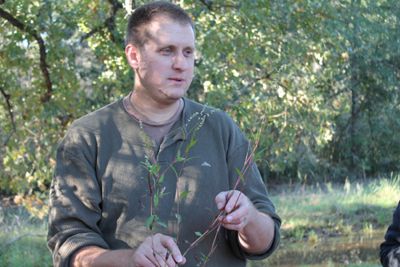 “Most of us with yards have five to 10 edible wild plants” said Suter. “You don’t have to be in a backwoods wilderness area to use wild plants. They’re all around us, even in vacant lots. Foraging has added a lot to my diet. Wild plants are often better for you than grocery store produce. I don’t even take vitamins anymore.”
“Most of us with yards have five to 10 edible wild plants” said Suter. “You don’t have to be in a backwoods wilderness area to use wild plants. They’re all around us, even in vacant lots. Foraging has added a lot to my diet. Wild plants are often better for you than grocery store produce. I don’t even take vitamins anymore.”
Mark Suter says edible wild plants are all around us, even in urban environments. Photo by Karla Patterson.
Off we went, exploring a broad no man's land behind high school sports fields off Fair Oaks Drive.
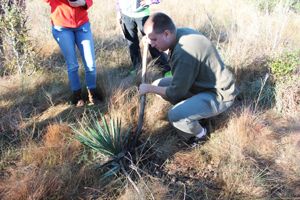 “This entire area is like a produce market,” said Suter, showing us wild lettuce growing beneath bleachers. Like most of the edible greens, it’s a touch bitter and would be best boiled, but tender young leaves are good raw.
“This entire area is like a produce market,” said Suter, showing us wild lettuce growing beneath bleachers. Like most of the edible greens, it’s a touch bitter and would be best boiled, but tender young leaves are good raw.
Mark Suter demonstrates his Native American digging tool on a hike in College Station. Photo by Karla Patterson.
For 90 minutes, we took a gastronomic botany tour of the nondescript field, enjoying trail nibbles along the way. Always looking down as we hiked, the anonymous greenery came into individual focus. Learning the basics of botany, we discerned if the leaf was simple or compound, oval and round shape or lobed, smooth margined or toothed. We were taught about its flowers, stems and roots.
Because it was mid-March, we caught a lot of the edible greens in the low rosette stage, with the leaves newly emerged and almost butter lettuce tender. Many of the plants would get a foot or more tall by spring’s end.
Here's a menu of the botanical buffet we sampled:
• Henbit: Its scalloped leaves off a square stem were a bit wooly.
• Burr clover: Delicate and three-leafed, it had the strong leaf vein of real clover. Tasted very grassy, but pleasant. “All clovers are edible,” said Suter. “Some taste better than others.”
• Lemon sorrel: A clover lookalike with teeny yellow flowers shaped like a ball. All were edible. Was lemony as advertised. A violet sorrel is mellower.
• Shepherd’s purse: A very fun plant already headed to seed, with heart-shaped pods and leaves on a short stem. We pulled the stem through our teeth for a mouthful of fresh peppery deliciousness. Flowers, leaves, root are edible and can be boiled when the plant is more mature. Often found in disturbed urban areas.
• Stork’s bill: The compound feathery leaves were too chewy, and I spit it out. The entire plant, including bill-shaped seedpods are edible.
• Dock: The large, long, oval leaves seemed like would make an excellent cooked green, but a hard chew. All types of dock are edible and grow in moist soil.
• Common chickweed: The teeny leaves and ten petal white flowers were yummy. Best enjoyed raw.
• Corn salad: Looked and tasted like butter lettuce. Incredible. Look for it in native seed displays.
• Spreading hedge parsley: A member of the carrot family with the same feathery leaves, it was chewy.
The class moved to the lush, creek-bottom section of Fair Oaks Park along Merriman Parkway. The boon here was plentiful wild onions. Easy to identify with strap leaves from a central base. “If it smells like an onion, it is an onion,” said Suter.
Because the outer layers can be peeled off, it can be eaten on the go without washing. We munched on another with very thin hollow garlic-like leaves. The juicy LaSuer pea-sized bulblets were pungent and fun.
After a trail nibble of violet flowers, it was on to trees. Alas, most were not in season or suitable for munching raw.
• Hackberry: Can suck the pulp off the berries in late summer to winter. Much more fascinating was round galls that arise from insect damage. The pulpy growths can be boiled.
• Mulberry: Sweet raspberry-like fruit on a tree. What could be better?
• Redbud: The purple flowers and even the tender leaves are edible, and the young seed pods are cooked like snowpeas.
Below, edible redbud flowers. Courtesy of Ladybird Johnson Wildflower Center/Ray Mathews.
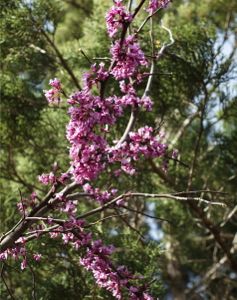 • Oaks: A significant food for Native Americans, the acorns are hulled, ground, and processed with running water to remove tannin. It’s blended with grain flours to raise the protein content.
• Oaks: A significant food for Native Americans, the acorns are hulled, ground, and processed with running water to remove tannin. It’s blended with grain flours to raise the protein content.
• Elderberry: A lowland shrub form has pyramidal bunches of teeny flowers that can be battered and fried like a fritter. The mature berries are edible but astringent; best made into wines and jams. The rest of the plant is toxic.
Suter cautioned to stay away from places where pesticides and herbicides are used. If harvesting around water sources that might have bacteria and most urban and farm areas do, be sure to rinse well.
“Just use common sense,” he counseled.
Be sure to have landowner permission before foraging. It’s verboten in most state and national parks, but highway departments often turn a blind eye. Stay away from areas with concentrated exhaust.
“Most of the poisonous plants you will find in this part of Texas won’t kill you,” said Suter, “just make you sick. But you do need to be aware of the lookalikes, in the carrot family especially since it contains hemlock. Mushrooms are a little more tricky, and you should study more before trying those."
Always, stressed Suter, forage with conservation in mind.
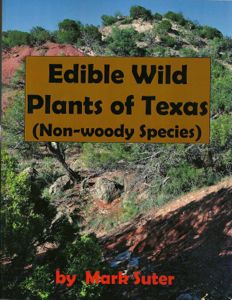 “Be aware that animals depend on the plants. Only take what you need that doesn’t negatively impact them. Only harvest from plants that are plentiful and not endangered or threatened. We must be conservative minded. That’s as important to me as using edible wild plants.”
“Be aware that animals depend on the plants. Only take what you need that doesn’t negatively impact them. Only harvest from plants that are plentiful and not endangered or threatened. We must be conservative minded. That’s as important to me as using edible wild plants.”
If you want to learn more of Suter's lore, his big, glossy, photo-filled book, Edible Plants of Texas, is available at his website PrimitiveTexas.com. Working with wife Amy Suter out of their College Station home in Central Texas, he teaches standard survival skills classes and the making of bows and arrows. He leads five and seven-day wilderness survival camps for teens and adults.
Stay up to date on everything green in North Texas, including the latest news and events! Sign up for the weekly Green Source DFW Newsletter! Follow us on Facebook and Twitter. Also check out our new podcast The Texas Green Report, available on your favorite podcast app.









